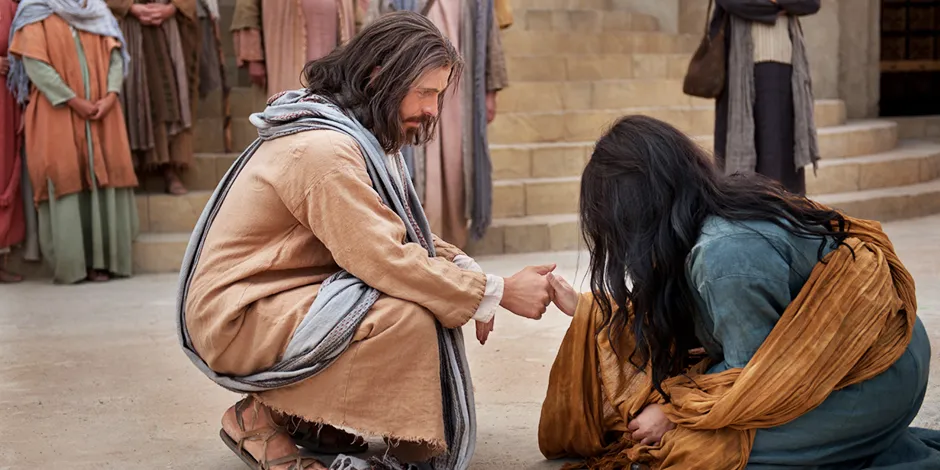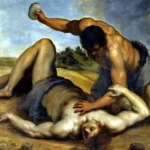In the scene portrayed in John 8, Jesus skillfully deals with the situation when a woman apprehended in adultery is brought before him by the Pharisees. His response is to comment and then write in the sand. While the nature of his doodles in the sand remains a mystery, some interpret it as possibly the sins that the Pharisees themselves grappled with, while others see it as a tactic to switch focus away from the woman.
The story of the adulterous woman in John 8 is a popular – and powerful – story in John’s gospel. It has long been a mystery what exactly Jesus was doing when he knelt down to write on the ground. What was He writing? Was He drawing a picture? No one knows for certain, but we’ll take a look at a few different theories.
The Story of the Woman Caught in Adultery
In this story from John 8, the scribes and Pharisees brought a woman caught in adultery to Jesus in a kind of challenge to Him and an unfair trial for her. They asked him what should be done with her, testing him to see if he would contradict the law of Moses, which commanded that she be stoned to death. It’s notable that just the woman was brought – Jewish law says that both parties should be punished. She was the one brought into public, likely wearing little clothes, and shamed – while the other party remained in unknown.
Jesus did not immediately respond, but instead, stooped down and wrote on the ground with his finger. When they persisted in their questioning, he stood up and said that whoever was without sin should be the first to throw a stone at her.
The accusers were convicted by their conscience and left one by one, until only Jesus and the woman remained. Jesus asked her if anyone had condemned her, and she replied that no one had. He then told her that he did not condemn her for her adultery, but to go and sin no more.
What Jesus Wrote on the Ground: Some Theories
But Jesus stooped down and wrote on the ground with His finger, as though He did not hear.
John 8:6b
How could you not love this Jesus? It’s obvious the scribes and pharisees are trying to trap Him. His options are:
- Let her go and – in a sense – take lightly the law of Moses
- Demand she be stoned, a harsh penalty
Rather than choosing one or the other, Jesus simply bends down and starts writing on the ground. From His birth until the day He carried His cross to His death, He was doing things like this: ushering in a new Kingdom through unexpected, loving, and often surprising acts.
He Wrote the Names of the Accusers
Some early theologians’ theorized Jesus was writing the names of the accusers in the sand. He did this to simply highlight their sin, taking the attention and focus off of the woman’s sin and onto their own. This wouldn’t have been explicit, but after a few moments of silence, the pharisees may very well have understood what He was doing, and felt the weight of their sin.
Some who like this theory also point to the fact the pharisees and scribes dropped their stones from oldest to youngest, assuming the oldest would’ve felt the weight of their sin first.
He Wrote the Pharisees’ Sins in the Sand
Another theory is that Jesus actually wrote the sins of the pharisees and scribes in the sand. I like this theory a lot. It points to a major shortcoming of the pharisees (and the church today) that some sins were held as being more taboo than others. Adultery certainly fell (and still falls) in this category. We’re quick to point the finger at those who struggle with sexual sin, but slow to speak to gluttony, anger, pride – more “casual” sins.
He Was Diverting Attention By Drawing on the Ground
One thing worth noting: the Greek word used for “wrote” is κατέγραφεν (kategraphen). This can mean to write, but it can also mean to draw. In other words, it’s very possible Jesus was simply doodling. He wasn’t writing anything specific, just diverting attention away from the woman and onto Him.
Within this theory is also the idea that Jesus was biding His time by drawing in the dirt. Have you ever asked a dumb or revealing question to someone that goes unanswered. Sometimes those moments of silence convict us and reveal the wicked heart of the question. Perhaps Jesus was letting the wickedness at the heart of their challenge sit with them for a few moments.
Our Take on What Did Jesus Wrote on the Ground
I tend to lean toward the third theory, that Jesus was simply diverting attention and not writing anything specific. Most notably because of the phrase, “as though He did not hear.” Jesus knelt down and wrote in the sand as if He didn’t even hear them.
In my opinion, this points most likely to simple doodling. Not to mention, depending on how close they were to Him, they may or may not have been able to read what He was writing. Jesus would have had to do some maneuvering to write each name in large letters.
At the end of the day, what He wrote doesn’t matter nearly as much as the gist of His actions. He exhibits such compassion and such wisdom in a single act. He handles the challenge perfectly. He doesn’t nastily condemn the pharisees and He restores the woman. That’s His heart for you as well. He’s certainly aware of your sin, but His heart is to restore. Go, and sin no more. This is what He died for.






